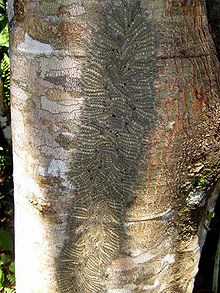

The collective behaviors of social caterpillars falls into five general categories: collective and cooperative foraging, group defense against predators and parasitoids, shelter building, thermoregulation and substrate silking to enhance steadfastness.
The most behaviorally sophisticated of the insect societies are found among the ants, termites, bees, and wasps. While these insects are technically classified as eusocial insects they are commonly referred to simply as the social insects. In this scheme of classification, other non-eusocial, gregarious species of insects are referred to as presocial, subsocial, quasisocial, or in some other manner that has the unfortunate consequence of suggesting that are not quite social. Yet a significant number of insect species that do not possess the defining criteria of eusociality are by any other standard of classification clearly social and it is in this sense of the term, that employed by zoologists in general, that larval aggregates of moths, butterflies and sawflies are considered social insects.
The sibling societies of caterpillars exhibit collective behaviors that vary from simple interactions to more complex forms of cooperation.